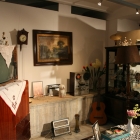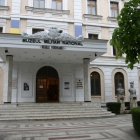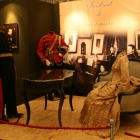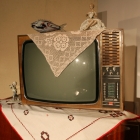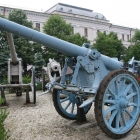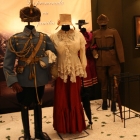The Military Museum of Bucharest. Images from communism, the Revolution
The Museum of Military History in Bucharest, found on Mircea Vulcănescu Street, is almost a century old, but obviously was transformed to include the participation of Romanian army in two world wars, a revolution and other events. It was given the name of King Ferdinand, the German monarch who achieved the great reunification of 1918. The various areas in which the army was involved in Romania’s contemporary history made it accommodate a wide range of exhibits and collections. You will find the usual uniforms of different ages and classes as well as weaponry. But you will also see unexpected items such as: the flying device used by Traian Vuia in 1906, when he made world history by flying with the first device heavier than air and without external propulsion. Or the space costume used by Dumitru Prunariu, the only Romanian cosmonaut who left Earth’s atmosphere in a Soviet rocket.
Among the regular army uniforms, one stands out: its the uniform stained with blood, worn by Vasile Milea, the last communist Defence Minister. After taking part at the brutal repression of street protesters against the regime of Nicolae Ceaușescu, in Timișoara, Milea was accused by the dictator for not taking decisive enough measures. Some say he had a change of heart or that he was from the beginning part in a conspiracy determined not to support the regime further. The general was found shot, the dictator announcing that the acted as a traitor, who shot himself when discovered. Some think it was a feeling of guilt or fear, others are convinced he was actually killed. Although he is a controversial figure, this last leader of the army has now his name given to one of the main boulevards in Bucharest.
The anticommunist Revolution of December 1989 is presented at large in this museum, because of the controversial but decisive role played by the army in it. You will find here a somber memorial to 1.100 plus victims (of which many were soldiers). But also an exhibition that evokes the day to day life during communism, which might make foreigners even more curious. Especially the decade of the 80s, when the country was struggling to pay the entire debt to IMF and foreing creditor was marked by food shortages, with long lines at store doors, war-like ratios when buying almost anything from sugar, oil, meat and even bread. A large portion of food from the otherwise rich soil of the country was headed to export in search of the needed dollars. At the same time, almost all imports were stopped, which marked a disconnect from Western technology, making the local produced electronics and home appliances look even more outdated than the usual museum pieces.
The uniform was ever present in the life of Romanians under communism, not just for those serving in the military. Which in itself was very vast at the time, due to the existence of the draft. From as early as kindergadern, children were enrolled in some sort of organization with political echo. It was first the funny looking orange and blue uniform of kindergarden children, called „hawks of the fatherland”. In the elementary school, you had to dress the white shirt with black trousers or skirt. Somewhere in the second grade, you were given the red scarf of „pioneer”, in a public ceremony. A uniform somewhat inspired from that of boyscouts, or from a royal youth organization under Carol II. The „pioneers” with highers marks were given colored strings resembling decorations, which they proudly worn in and on the way to school. Red, for group leader, yellow for class leader and blue for best in school. In highschool, the uniform changed slightly, with the shirt in blue tone and a dark tie. At the end of high-school you could already be enlisted in the organization of young communists, the antichamber of party members. Which grew from an insignificant organization before the Soviet occupation, into a mass organization of millions, less relevant as a political group and more like another way of saying the establishment or the administration at local and central level.
Many things were meant to look alike during communism: the blocks were gray and without decorations, the clothes were mass produced by large factories, with few variations or line options. It was not uncommon to see people dressed alike not necessary because they followed a fashion trend, but because they wouldn’t find much diversity in stores. Even home decoration items were alike. This marked the appearence of a style we can call communist kitsch, with the home made lace brodery, the painted glass fish or the same balerina made of china, found in many flats. Many of the city inhabitants were former peasants brought to work in the large state factories, trying to adapt their artistic sensibilities to the limited offer of socialist commerce of art goods.
The anticommunist Revolution of December 1989 put an end to dictatorship, bringing open market and democracy. For many, the shortages ended, sometimes being replaced with the abundance of the supermarket. For others, living in poverty, it meant facing tougher realities of transition and capitalism like unemployment, unaffordable housing. The event itself was marked by acts of splendid heroism from regular people facing bullets and tanks in the streets for the sake of freedom and patriotism, with a noble sense of idealism. It was also an event of high hopes and social cohesion against a detested regime. But it is marked by the unnecessary loss of over a thousand lives in unclarified conditions. The rumours about terrorists, presumably defending the regime, were eventually dismissed as disinformation, but the panic ensued and the fire usually from army weapons cost many lives. Some acts of diversion were largely documented, intentionally causing soldier groups to kill each other assuming they are fighting terrorists.
176 officers, of which 18 generals were brought to trial, of which 12 from Militia (the Police) and 6 from the Army. Apart from Ceaușescu couple, executed after a stalinist type of trial dubbed “revolutionaly tribunal”, 24 Communist Party leaders were taken to court. Many escaped with short sentences due to judicial proceedings objections or on medical grounds. During the mandate of Ceaușescu’s successor, Ion Iliescu, many were pardoned. A Nurenberg type of trial was carried in 1990 against the entire Central Executive Committee of the Communist Party. The trial was televised but later the condemned were pardoned by presidential decree. Even the anti-communist president Emil Constantinescu pardoned the former Interior minister after serving only 3 years of his jail sentence for age reasons. Over 600 people, more than half of Revolution’s victims, were military officers or drafted soldiers.
The role of the army in society decreased after that event. Actually, from the second world war, this institution was never influential in political decisions of the country, as it happened in other authoritarian regimes. The more mysterious Securitate (the secret service) held a key role, if not dominant, during communism and grew in influence in democracy, with an ever growing number of agents. Romanian army’s size decreased after it gave up drafting young men at the end of nineties to about 60.000 strong. Many factories of weaponry, that once made Romania a top 5 exporter in the world, were closed or reduced production. Instead, the army turned to the West, buying new or used weaponry, fighter jets and boats especially from United States. It is one of the few NATO countries that actually abides the promise of spending 2% of its GDP, about 6% of its national budget for acquisitions. Romanian soldiers were part of NATO operations in Afghanistan and Iraq, with fatal casualties and and appreciated role.
United States have built two military bases in Romania (with a third one being proposed). In one of them the anti-missile shield is found, which is a component of European defense, but which Russian president Putin considers a potentially offensive rocket system, against which he even evoked the threat of nuclear retaliation.
- Home Page
start page - Architecture
landmark buildings - Sacred architecture
places of worship - Nature
landscape photography - Concert
performing artists - Christmas
Santa Claus pictures
- Jooble
jobs for photographers - Escape
an out of control blog - Merry Christmas
The best organizer of Christmas parties - Astro photo
Eclipse hunting and astrological photography





